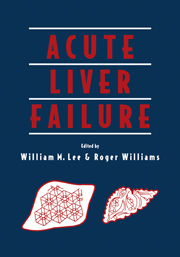Book contents
- Frontmatter
- Contents
- Preface
- Foreword
- Acknowledgments
- Contributors
- Part One Clinical Syndrome and Etiology
- Part Two Mechanisms of Disease and Multisystem Involvement
- 7 Role of cytokines and immune mechanisms in acute liver failure
- 8 Pathology of acute liver failure
- 9 Hepatocyte replication and liver regeneration
- Part Three Intensive Care Management
- Part Four Transplantation
- Part Five Artificial and Bioartificial Liver Devices
- Part Six Other Applications
- Index
- Plate section
9 - Hepatocyte replication and liver regeneration
from Part Two - Mechanisms of Disease and Multisystem Involvement
Published online by Cambridge University Press: 20 May 2010
- Frontmatter
- Contents
- Preface
- Foreword
- Acknowledgments
- Contributors
- Part One Clinical Syndrome and Etiology
- Part Two Mechanisms of Disease and Multisystem Involvement
- 7 Role of cytokines and immune mechanisms in acute liver failure
- 8 Pathology of acute liver failure
- 9 Hepatocyte replication and liver regeneration
- Part Three Intensive Care Management
- Part Four Transplantation
- Part Five Artificial and Bioartificial Liver Devices
- Part Six Other Applications
- Index
- Plate section
Summary
INTRODUCTION
Hepatocytes are highly differentiated cells which have little proliferative activity in adult livers of humans or animals. Nevertheless, the proliferative capacity of hepatocytes is not lost and is rapidly activated in response to decreases in functional hepatic mass caused by tissue resection or cell death (Bucher and Malt 1971; Fausto and Webber 1994). During the last few years much new information has become available on the role of transcription factors, proto-oncogenes and growth factors as mediators of the process by which quiescent hepatocytes enter the cell cycle and replicate. Most of this knowledge has been obtained from studies of liver regeneration after partial hepatectomy (PH) in rodents and from work with cultured hepatocytes. In liver regeneration induced by partial hepatectomy, hepatocyte replication occurs in the absence of concomitant cell death and fibrogenesis. Thus, the system is most suitable for the analysis of the molecular mechanisms of hepatocyte replication and growth factor effects. More over the results of these studies are applicable to the understanding of growth regulation in human livers. However, hepatocyte replication in humans often takes place in diseased livers in which the tissue architecture is grossly altered, or, in the case of acute hepatic failure, in an organ with massive cell death and impaired function.
It is not known whether the molecular mechanisms of hepatic replication after partial hepatectomy of a normal organ differ from those which regulate hepatocyte proliferation after severe injury.
- Type
- Chapter
- Information
- Acute Liver Failure , pp. 93 - 114Publisher: Cambridge University PressPrint publication year: 1996



